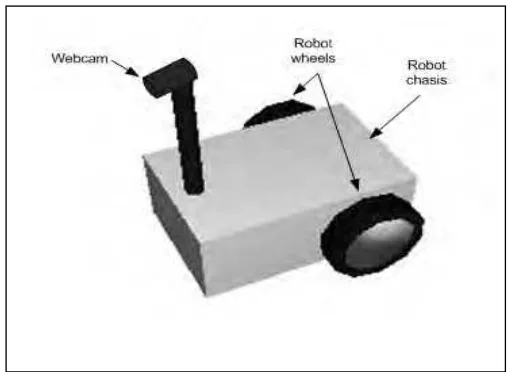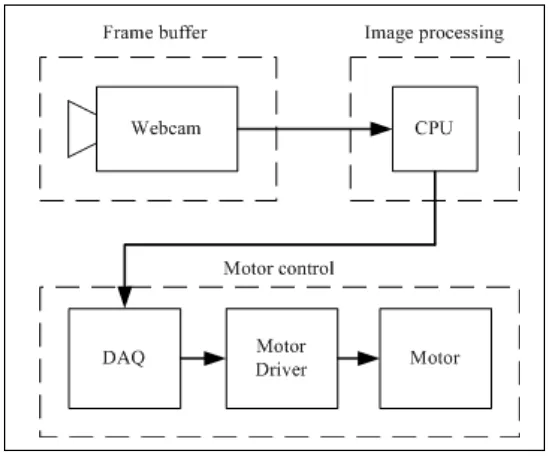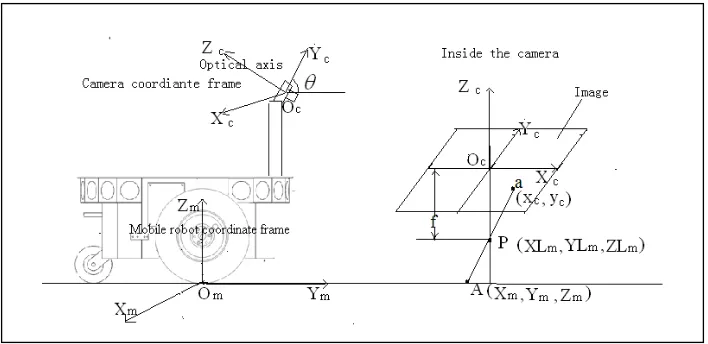UNIVERSITI TEKNIKAL MALAYSIA MELAKA
PERFORMANCE ANALYSIS OF VISION-BASED CONTROL FOR
AUTOMATED GUIDED CART
This report submitted in accordance with requirement of the Universiti Teknikal Malaysia Melaka (UTeM) for the Bachelor Degree of Manufacturing Engineering
(Robotic and automation)
by
WAN ZAFRI BIN WAN ZAINOL B050810062
UNIVERSITI TEKNIKAL MALAYSIA MELAKA
BORANG PENGESAHAN STATUS LAPORAN PSM
TAJUK: Performance analysis of vision-based control for automated guided cart
SESI PENGAJIAN: 2010/ 11 Semest er 2
Saya WAN ZAFRI BIN WAN ZAINOL
mengaku membenarkan t esis (PSM/ Sarj ana/ Dokt or Falsaf ah) ini disimpan di Perpust akaan Universit i Teknikal Malaysia Melaka (UTeM) dengan syarat -syarat kegunaan sepert i berikut :
1. Tesis adalah hak milik Universit i Teknikal Malaysia Melaka dan penulis.
2. Perpust akaan Universit i Teknikal Malaysia Melaka dibenarkan membuat salinan
unt uk t uj uan pengaj ian sahaj a dengan izin penulis.
3. Perpust akaan dibenarkan membuat salinan t esis ini sebagai bahan pert ukaran
ant ara inst it usi pengaj ian t inggi.
4. *Sila t andakan (√)
SULIT
TERHAD
TIDAK TERHAD
(Mengandungi maklumat yang berdarj ah keselamat an at au kepent ingan Malaysia yang t ermakt ub di dalam AKTA RAHSIA RASMI 1972)
(Mengandungi maklumat TERHAD yang t elah dit ent ukan oleh organisasi/ badan di mana penyelidikan dij alankan)
(TANDATANGAN PENULIS)
DECLARATION
I hereby, declare that this report entitled “Performance analysis of vision-based control for automated guided cart” is the result of my own research except as cited in references.
Signature :
Author’s Name : Wan Zafri B. Wan Zainol
APPROVAL
This report is submitted to the Faculty of Manufacturing Engineering of UTeM as a partial fulfillment of the requirements for the degree in Bachelor of Manufacturing Engineering (Robotic and Automation). The member of the supervisory committee is as follow:
……… (Madam Nur Aidawaty Binti Rafan)
Main Supervisor
i
ABSTRAK
Projek ini membentangkan mengenai analisis prestasi yg dilakukan terhadap kereta automatik berpanduan yang dikawal oleh gambaran berasas mengunakan ‘visual basic’. Pada masa ini, penderia digunakan pada kereta automatik berpanduan dan ia hanya bolen mengesan garisan. Untuk projek ini, ia menggunakan gambaran untuk pelayaran. Projek ini akan menfokuskan pada analisis prestasi yg dilakukan terhadap kereta automatik berpanduan yang dikawal oleh gambaran berasas. Selain daripada menganalisis prestasi yg dilakukan terhadap kereta automatik berpanduan, ia juga memasang gambaran berasas pada kereta automatik berpanduan. Hasil daripada pemasangan ini, analisis prestasi gambaran berasas dapat dijalankan dengan beberapa eksperimen untuk projek ini. Eksperimen ini akan mengutamakan pada prestasi yang akan dicapai oleh kereta automatik berpanduan. Pada akhir projek ini, pemasangan dan analisis prestasi telah berjaya dilaksanakan dan kereta automatik berpanduan telah mencapai tahan stabil dan kecekapan dari keputusan yang telah dibuat dari eksperimen. Tahap prestasi sebenar kereta automatik berpanduan akan memberi sumbangan pada pembelajaran masa depan.
ii
ABSTRACT
iii
ACKNOWLEDGEMENT
iv
DEDICATION
vi
vii
5.4 Conclusion 66
6. CONCLUSION & RECOMMENDATION
6.1 Conclusion 67
6.2 Recommendation 68
REFERENCES 69
viii
LIST OF FIGURES
1.1 Example of automated guided cart and path planning 1.2 Gantt cart for PSM1 and PSM2
2.1 Concept design of the mobile robot platform 2.2 Mobile robot configuration system
2.3 Coordinate frames for the mobile robot and the camera 2.4 Integrated robot navigation process
2.5 Example of Webcam 2.6 SK40C
2.7 USB to UART Converter 2.8 UART Converter
2.9 Each pixel has a value from 0 (black) to 255 (white)
3.1 Flow Chart of the Overall Project Process 3.2 Flow chart of the Planning Phase
ix
4.1 Body for AGC 4.2 Web cam at AGC
4.3 Before and after fabrication of AGC 4.4 Three point detection at visual basic 4.5 Program for web cam declaration 4.6 Image display in visual basic software 4.7 Rectangle shape and point detection 4.8 Overall display in Visual Basic
4.9 Flow chart for operation in visual basic
4.10 Connection between computer and microcontroller 4.11 Program in MikroC
4.12 Several circuits for controller
4.13 PIC 16F877A attach to the SK4OC circuit 4.14 PIC 16F877A connection between components 4.15 L293D motor drive
4.16 DC motor controller using L293D 4.17 AGC after development
5.1 Line chart for color range 5.2 Motion of AGC in 41 minutes 5.3 Arrangement of wheel for AGC 5.4 AGC wheel
5.5 New wheel of AGC
x
LIST OF TABLES
2.1 Software function
2.2 The parent and the family code of the PIC microchip 2.3 Color Palette
3.1 Microcontrollers device overview and its properties (Microchip.com, 2002) 3.2 Microcontroller features as guide to selection (Microchip.com, 2002) 3.3 DC motor specification
xi
LIST OF ABBREVIATIONS
1
CHAPTER 1
INTRODUCTION
1.1 Background
Automated guided vehicles (AGVs) is a material handling system that uses independently operated, self-propelled vehicles guided along defined pathways. An automated guided vehicles (AGVs) also can intend as a mobile robot that follows markers or wires in the floor, or uses vision or lasers. AGVs increase efficiency and reduce costs by helping to automate a manufacturing facility or warehouse. The AGVs also called as automated guided carts (AGCs).
In this project, vision-based control will be developed for automated guided carts. This project is mainly on the analysis performance of vision-based control for automated guide cart. To increase the performance of this vision in robotic system, the performance analysis should be done. From installation, experimentation, implementation and evaluation will be discussed in this project.
2 1.2 Problem statement
The current automated guided carts or AGCs use magnetic tape for the guide path. The AGCs is fitted with the appropriate guide sensors to follow the path of the tape. With used the magnetic sensor, it will be depend to line for mobile robot motion. For this project, vision will be used in servo-based control for automated guide cart. It can detect many objects in area (image) for smoothly movement and tasks given. This project is to analyze the performance of vision-based control for automated guide cart. The significant of this project is to develop and study the performance of vision servo-based control based on analyzes that will be done. The purpose of this project is to compare the actual performance and measure vision-based control performance. In the end of project, the performance of vision-based for automated guide cart will be done with experiment, discussion and result that produced in project.
1.3 Objective
The objectives of this project are:
1. To develop vision-based control for automated guide cart.
2. To study performance of vision-based control for automated guide cart.
3 1.4 Scope
5
CHAPTER 2
LITERATURE REVIEW
2.1 Introduction
In this chapter, the review of information is to support the knowledge and skills before start the project. The journal relates will be carried out in term of software design, hardware design and image processing approach that can give some information or ideal for this project. The project requirement will be list and then the research for this equipment and software will be do it and continuously with implement of project for the next chapter.
2.2 Development of vision-based control at AGC
6
(A. H. Ismail, 2009) said in the vision-based application is proposed for a line following mobile robot. A low-cost webcam is used as the sensor and the image buffers are processed via a customized image segregation method to output necessary information for the mobile robot controller under uncontrollable lighting condition. Mobile robot navigation based on lines, landmarks and signs have been widely implemented around the globe.
The camera mounted mobile robot, termed an AGV (Autonomous Guided Vehicle) in the literature, is intended for the use of navigation within an industrial or factory environment. As such, the AGV is trained to recognize the different possible line shapes captured by the camera and respond accordingly. It has even been equipped with an obstacle avoidance algorithm as such accidents are very prone to happen in a factory environment. While very advanced for its time, the processing time required for this work is too lengthy for use in many real-time applications, as it takes as long as 300ms to process a single image. This is mainly due to the highly complex technique used as well as hardware limitations of the time. Processing time is a usually a big concern when involving robots that perform their tasks in real time. The robot used in this study is custom made and designed specifically for autonomous line following uses. Its chassis is made from aluminum.
7
A common USB camera is mounted on the frontal part of the robot at an angle as to view the path as far as 0.5m ahead without having a blind spot underneath the camera. The camera captures videos with 160 x 120 resolutions at 30 frames per second in RGB format. The video data is then sent to a National Instruments Data Acquisition Card (DAQ) model NI-DAQ6009 for processing using an onboard laptop via USB. The diminutive laptop is equipped with a 1.66 GHz Intel processor, 1 GB of RAM and 80 GB of hard disk space.
Figure 2.2: Mobile robot configuration system
8
compared to the previous three. The processing time is further reduced by reducing the image size from 160X120 to 40X30.
(Nasser Houshangi, 2009) present a vision-based autonomous lane following system for a mobile robot. Vision is an essential information source for the autonomous ground vehicle (AGV) navigation applications. The primary task of vision is to provide a description of the world rich enough to facilitate such behavior as road-following, obstacle avoidance, landmark recognition, and cross-country navigation. The current motivation is to improve AGVs navigation techniques by expanding their autonomy, capabilities and their usefulness.
Several steps are taken to detect and represent the lane position using vision information. First, the coordinate frames for the mobile robot and the camera are assigned. The camera is calibrated with respect to the mobile robot coordinate frame. The captured image from the camera is processed in the camera coordinate frame and transformed to the mobile robot coordinate frame to determine the lane position. Each step is explained as follows. A single camera is fixed on a stand which is attached to the front of a mobile robot as shown in Fig. 2.3. The mobile robot is modeled as a rigid body with two differential driving and one caster wheel.
9
The camera is modeled as a pin-hole camera. The perspective center P of the camera, the point A on the ground, and A’s projection on the image are connected by an image ray as shown in Fig. 2.11. A single image can be thought of as a bundle of such rays converging at the perspective center with an unknown position and orientation in space which can be identified by the camera calibration process.
At each time interval a 24 bit RGB format 360× 240 pixel image of the lane is captured by the camera. The captured image is converted to grayscale image using NTSC television standard. This information is transformed to mobile coordinate frame and robot position and orientation with respect to the lanes are determined. Based on current and desired robot position and orientation, the planner generates the desired robot wheel velocities for the controller. The integrated robot navigation process is shown in Fig. 2.4.
Figure 2.4: Integrated robot navigation process
With all journals above, the ideal for hardware design, software design and image processing approach can be apply at this project. For the software design, the convenient method is the most important in the selection of software and image processing that will be do it. In the hardware design, the selection of fabrication for frame and location of wheel at AGC is the important for this project.
10
software with their function and it utility for this project. To control the operation in the automated guided cart several software will be use. The election for the software based on suitability and contentment between hardware and software that used for visual-based at automated guided cart.
Table 2.1: Software function
Software Function Utility for project
1. MikroC software
MikroC PRO for PIC is a full-featured C compiler for PIC microcontroller from Microchip. It is designed for developing, building and debugging PIC-based embedded applications.
This development environment has a wide range of features such as easy-to-use IDE, very compact and efficient code, hardware and software libraries,
The advantages of C-Compiler are to provide higher level programming for designer to solve their problem faster and more efficient. After the C file is compiled, if there is no error in the program a hex file will generated





